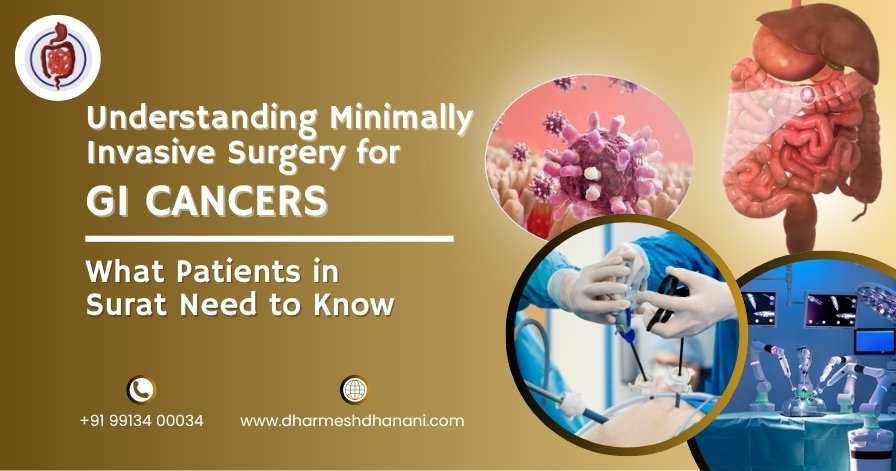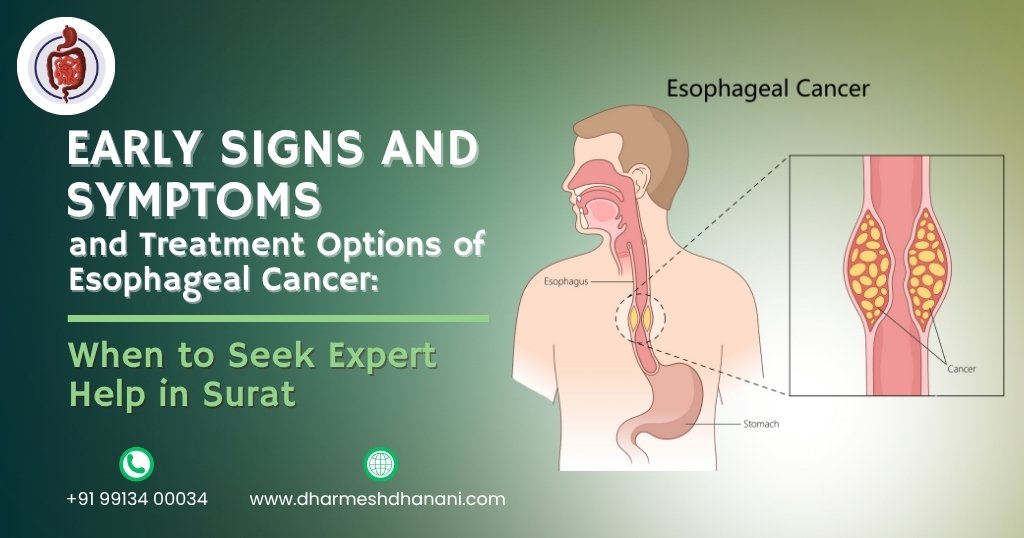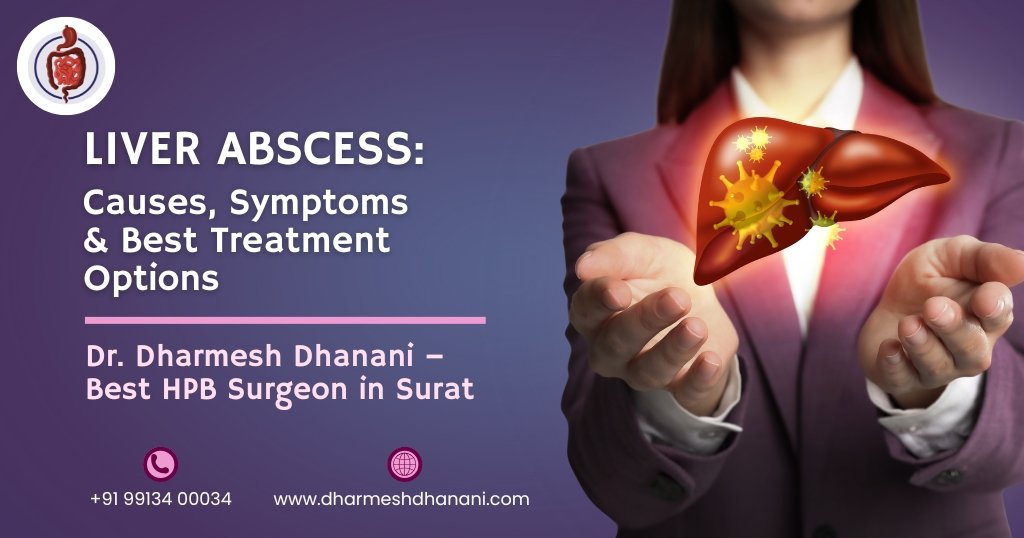
- +91-8808808186
- 11:00 AM - 01:00 PM | 04:00 PM - 06:00 PM
Best Robotic, Laparoscopic, Bariatric, Gastrosurgeon of Surat

Dr Dharmesh Dhanani
MS, FNB (Minimal Access Surgery), FACS, FALS, FMAS, FAIS
Consultant Gastrosurgeon, Bariatric & Laparoscopic Surgeon
Gallbladder cancer is a rare but potentially dangerous form of cancer that starts in the gallbladder, a small organ located just beneath the liver. While it is not as commonly diagnosed as other types of cancer, it can be life-threatening, particularly when detected in later stages. In this blog, we will explore the causes, symptoms, diagnosis, treatment options, and prevention strategies related to gallbladder cancer, empowering you to take the necessary steps for early detection and intervention.
What Causes Gallbladder Cancer?
Gallbladder cancer arises from abnormal growth of cells within the gallbladder. The exact causes of this condition remain unclear, but several factors are known to increase the risk of developing this type of cancer:
- Gallstones: The most significant risk factor for gallbladder cancer is the presence of gallstones. People with chronic gallstone disease are at a higher risk due to the inflammation and irritation these stones can cause in the gallbladder over time.
- Chronic Inflammation: Long-standing inflammation of the gallbladder, such as in the case of chronic cholecystitis, increases the likelihood of cancer development. This condition is often linked to untreated or recurring gallstones.
- Age and Gender: Gallbladder cancer is more common in individuals over the age of 60, and women are more frequently diagnosed than men.
- Genetic Factors: Family history and genetic conditions such as polyposis syndromes or Lynch syndrome can increase the risk of developing gallbladder cancer.
- Bile Duct Abnormalities: Certain abnormalities in the bile ducts, such as primary sclerosing cholangitis (PSC), may also increase the risk.
- Obesity: Excessive weight and related conditions, including diabetes, can increase the likelihood of developing gallbladder cancer.
- Exposure to Chemicals: Exposure to certain industrial chemicals or toxins may be a contributing factor in the development of gallbladder cancer.
Symptoms of Gallbladder Cancer
Gallbladder cancer often develops without obvious symptoms in its early stages, which makes early detection particularly challenging. When symptoms do appear, they may be vague and overlap with other gastrointestinal conditions. Common symptoms include:
- Abdominal Pain: Persistent pain, often in the upper right part of the abdomen, is one of the first signs of gallbladder cancer. The pain may worsen after eating and could be accompanied by a feeling of fullness or bloating.
- Jaundice: Yellowing of the skin and eyes, known as jaundice, occurs when the liver cannot effectively process bilirubin due to a blockage in the bile ducts, a common occurrence in gallbladder cancer.
- Unexplained Weight Loss: Rapid, unexplained weight loss can be a sign of gallbladder cancer, especially when accompanied by other symptoms like fatigue or nausea.
- Nausea and Vomiting: Persistent nausea and vomiting, particularly when associated with eating or drinking, can occur in individuals with gallbladder cancer.
- Loss of Appetite and Fatigue: A noticeable decrease in appetite, coupled with chronic fatigue, may indicate an underlying issue such as gallbladder cancer.
- Abdominal Swelling: Fluid buildup in the abdomen (ascites) may occur in advanced stages of gallbladder cancer, leading to noticeable swelling.
These symptoms are also associated with other gallbladder diseases, such as gallstones or inflammation, so it is important to consult with a healthcare provider for accurate diagnosis and treatment.
How is Gallbladder Cancer Diagnosed and Staged?
When gallbladder cancer is suspected, a combination of diagnostic tests is performed to confirm the diagnosis and determine the stage of the disease. These tests may include:
- Blood Tests: Blood tests are used to assess liver function and detect elevated levels of certain cancer markers, such as CA 19-9, which may indicate the presence of gallbladder cancer.
- Imaging Studies: Imaging techniques like ultrasound, CT scans, or MRI are essential in detecting tumors, assessing their size, and identifying any spread to nearby organs.
- Endoscopic Retrograde Cholangiopancreatography (ERCP): This procedure involves using a camera to examine the bile ducts and may involve the removal of a tissue sample for biopsy.
- Biopsy: A biopsy involves taking a small sample of tissue from the gallbladder or surrounding area to confirm the presence of cancer cells.
Once diagnosed, the cancer is staged to determine its extent of spread. Gallbladder cancer is classified into several stages, ranging from localized tumors to advanced cancer that has spread to nearby tissues or distant organs.
Treatment Options for Gallbladder Cancer
The treatment for gallbladder cancer depends on the stage at diagnosis, the patient’s overall health, and the extent of cancer spread. Common treatment options include:
- Surgery: The primary treatment for localized gallbladder cancer is surgery. This may involve the removal of the gallbladder (cholecystectomy), and if the cancer has spread, the surgeon may also remove nearby lymph nodes or parts of the liver.
- Chemotherapy: Chemotherapy may be used to treat gallbladder cancer, either as the main treatment or as an adjuvant to surgery. It is used to target and destroy cancer cells throughout the body, particularly in cases where the cancer has spread.
- Radiation Therapy: In some cases, radiation therapy is used to shrink tumors or target cancer cells that cannot be removed surgically. It may be used alone or in combination with other treatments.
- Targeted Therapy: Targeted drugs are used to block specific molecules involved in the growth and spread of cancer cells, offering a more precise treatment approach.
- Immunotherapy: Immunotherapy helps the immune system recognize and attack cancer cells. This is often used in more advanced stages of gallbladder cancer.
- Palliative Care: In advanced stages of cancer, palliative care may be used to manage symptoms and improve quality of life. This can include medications to manage pain, nausea, and other discomforts.
Prevention and Prognosis
Although gallbladder cancer cannot always be prevented, there are steps you can take to reduce your risk:
- Maintain a healthy weight: A balanced diet and regular physical activity can help prevent obesity and related conditions like diabetes, which are risk factors for gallbladder cancer.
- Address gallstone issues: If you have gallstones, discuss treatment options with your doctor to reduce the risk of complications.
- Monitor for early signs: If you have a family history of gallbladder disease or other risk factors, regular check-ups and screenings can help catch potential issues early.
The prognosis for gallbladder cancer depends on the stage at diagnosis, the effectiveness of treatment, and the patient’s overall health. Early detection and timely treatment are critical for improving survival rates.
Conclusion
Gallbladder cancer may be rare, but its impact can be severe. Understanding the risk factors, symptoms, and treatment options is essential for anyone who may be at risk. If you experience symptoms such as unexplained weight loss, jaundice, or abdominal pain, consult with an expert to seek timely diagnosis and intervention.
Dr.Dharmesh Dhanani, a leading gastro cancer surgeon in Surat with over 15 years of experience, offers comprehensive care for patients diagnosed with gallbladder cancer. His expertise in early diagnosis, personalized treatment plans, and commitment to patient care ensure the best possible outcomes.
If you or someone you know is experiencing symptoms or is at increased risk of gallbladder cancer, don’t hesitate to reach out for professional guidance and care. Early intervention is key to improving the chances of successful treatment and recovery.
On Dr Dharmesh Dhanani
Related Posts

Understanding Minimally Invasive Surgery for GI Cancers – What Patients in Surat Need to Know
When it comes to treating gastrointestinal (GI) cancers, early diagnosis and advanced surgical techniques can make a life-saving difference. At Kiran Hospital, Surat, Dr. Dharmesh Dhanani, a renowned GI cancer and laparoscopic gastrosurgeon, is transforming cancer care through minimally invasive surgeries.we’ll help you understand what minimally invasive GI cancer surgery

Early Signs and Symptoms and Treatment Options of Esophageal Cancer: When to Seek Expert Help in Surat
Esophageal cancer, a serious condition affecting the food pipe (esophagus), is often diagnosed late due to subtle early symptoms. Early detection is crucial to improve survival and treatment success. In Surat, patients can access world-class care with Dr. Dharmesh Dhanani, a highly experienced Gastrointestinal Cancer Surgeon and Senior Consultant at

Liver Abscess: Causes, Symptoms & Best Treatment Options | Dr. Dharmesh Dhanani – Best HPB Surgeon in Surat
What is a Liver Abscess? A liver abscess is a pus-filled cavity within the liver caused by an infection. It results from bacteria, parasites, or fungi invading the liver tissue and forming a localized collection of pus. If not detected and treated early, a liver abscess can rupture and spread

Understanding Gallbladder Cancer: Causes, Symptoms, and Treatment Options in Surat
Gallbladder cancer is a rare but potentially dangerous form of cancer that starts in the gallbladder, a small organ located just beneath the liver. While it is not as commonly diagnosed as other types of cancer, it can be life-threatening, particularly when detected in later stages. In this blog, we